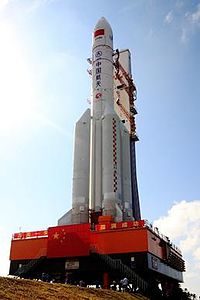
In the second part of the SpaceWatch Middle East multi-week theme on China’s Space Silk Road and the Middle East, Dr. Bleddyn E. Bowen of King’s College London, probably the greatest space power theorist in Welsh history, makes the case that space powers in the Middle East have a cornucopia of choice when it comes to cooperating and collaborating with the great space powers of the world – United States, Europe, Russia, India, Japan, as well as China’s Space Silk Road. Dr. Bowen argues that the multipolar space order is a boon for Middle East space powers, and that dependency on any one great space power should be avoided.
Today, the United States’ leadership in space – though still significant – is being challenged by the rise of China. Or, rather, this is the bipolar picture of the celestial order most media punditry presents. The reality is that the geopolitics of space is increasingly characterised by a multipolarity in the international system. For would-be space powers in the Middle East, this means that there is an increasing range of options to develop space capability and purchase services for purposes ranging from precision bombing to precision agriculture. China’s rise has masked the fact that the EU is on the verge of realising new levels of autonomy in space with its Copernicus and Galileo programmes; India has mastered complex cyrogenic launch technology, navigation augmentation, and small-satellite launches; Japan is militarising its space services; and Russia continues to provide significant launch capabilities and alternative services to the U.S. The space power designs of states in the Middle East, therefore, have quite the range of options for development and dependency distribution.
China has recently promoted its growth as a space power by encouraging projects under the goal of establishing a Space Information Corridor, which is a catch-all phrase for its space policy engagement along its busiest trade routes, in parallel with the catch-all strategic plan of “One Belt, One Road,” or the New Silk Road. Indeed, discussions of space power have been dominated by the rise of China – or rather, its return – as a great power in the international system. It is no surprise that as China develops its political, economic, military, and logistical support chains and markets across the Indian Ocean and the Gulf – sometimes dubbed the ‘String of Pearls’ – its space power should follow suit.
There is no doubt in the demand in the Middle East for space services, particularly in Earth observation or spy satellites involving every aspect of multispectral imaging. The region is at war. Precision weapons have been proven time and again as useful and efficient weapons, most recently by the Russian presence in Syria, but also for almost three decades by the United States and Israel. Indeed, even in the Iran-Iraq war, significant Iraqi advances in 1988 were the result of a U.S. space intelligence liaison. More recently, many Arab militaries have been engaging in close air support and surveillance missions, where precision weapons are ever-more useful. In wider economic terms, the Gulf states, in particular, are seeking to diversify their economies and increase the efficiency of their terrestrial resources. Space power allows just that.
The Middle East is a region at war – while also investing in high technology sectors and infrastructure development. Warfare and development are the sine qua non of space power and therefore a lucrative market for the big space powers. As Middle Eastern states continue to invest in high-technology capabilities such as air-based reconnaissance and surveillance, unmanned aerial vehicles, missile defence, and ground-based air defences, the demand for a space power backbone to network and connect their data requirements will only grow. Middle Eastern governments must consider in which areas they wish to develop sovereign capabilities through building or purchasing their own satellites, where to collaborate (like through ARABSAT), or where to co-develop or purchase from external powers for both warfare and development needs.
Despite recent launch failures, China can no doubt help provide services and build capacities in these areas. Few states in the Middle East are significant sovereign space powers, as seen in the table. Israel and Saudi Arabia are the most significant space powers in the Middle East and are currently highly dependent on the American space leviathan. With only a small mix of communications and reconnaissance satellites, there are clear gaps in sovereign capabilities such as launch, position, navigation, and timing, more varied Earth observation techniques, as well as research and development. China can indeed help these states bypass their space power shortcomings or provide a method to collaborate to build capacities under the New Silk Road moniker. Increasing access to Chinese space infrastructure – or the Space Information Corridor – allows China to compete with American preponderance in the dependency of most states on the strategic utility of its Global Positioning System (GPS) and commercial communications systems. With increased Gulf states dependency on space infrastructure, China could gain greater influence in regional power politics in the Middle East, particularly as the supplier of communications, reconnaissance, and precision warfare capabilities.
However, the Space Information Corridor is merely new window-dressing for the increasing prowess of China in high technology sectors since the late 1980s. It is easy to overplay China’s remarkable growth in space power at the expense of the continued development of other space powers. They have not been idle, and therefore do not necessarily need to worry too much about responding to the New Silk Road if they were already planning to compete with, or undermine, the growth of Chinese space power. The reality is that China is but one potential source of collaboration and sales for Middle Eastern space power needs or ambitions. As the table shows, there is arguably a multipolar system in orbit, where a handful of major space powers are able to offer a wide spectrum of space capabilities for purchase or collaborative development. The major powers have mastered core elements of comprehensive space power to varying degrees, and they can offer a range of capabilities outside the direct influence of Washington and Beijing.
Showing a potential model for other powers to follow – including Middle Eastern powers – is India’s approach to position, navigation, and timing services. India is now a full co-partner in the Russian GLONASS system, and it has also developed its NAVIC regional GPS augmentation satellites. This means that, on the Indian subcontinent, Indian armed forces will be able to rely upon precise navigation services in any major military confrontation. New Delhi may be calculating that in a major war, it is unlikely that both the United States and Russia would decide to cut off or attempt to disrupt Indian access to navigation signals. One may do so, but it is highly unlikely that both would in a supposed zero-sum relationship between Russia and America. China, through its almost-operational Beidou system, now provides a third navigation service, and Europe’s Galileo will provide a fourth.
Like India, Middle Eastern states have much to gain by distributing their space power dependencies as an insurance policy. They should avoid being taken in by China’s soft power offensive and recognise existing strengths in U.S., European, and other Asian space powers. The narrative of the return or rise of China does overshadow other options for military modernisation and development, which means the eggs of smaller space powers can be placed in many baskets.
This ‘concert’ of great space powers that possess autonomous launch, navigation, communication, observation, and space industrial capabilities provides ways for Middle Eastern states to spread their strategic space power dependencies and is symptomatic of the multipolar character of geopolitics in orbit today. As surely as the United States is facing a relative decline in its space dominance, China is also facing potentially stiff competition to sell and encourage dependencies on its own space infrastructure from other space powers in Europe and Asia. The Middle East could make the space powers of the multipolar order compete for their cooperation and investment.

Dr. Bleddyn E. Bowen is a Lecturer at the Defence Studies Department, King’s College London, housed at the Joint Services Command and Staff College, UK Defence Academy. Dr. Bowen’s research interests focus on spacepower theory and the role of space technology in contemporary strategy. He has previously published in The Journal of Strategic Studies and Astropolitics: The International Journal of Space Politics & Policy, and contributes frequently to his department’s blog, Defence-in-Depth.
Original published at: https://spacewatch.global/2017/08/swmethemes-chinas-space-silk-road-middle-east-chinas-new-silk-road-middle-east-multipolar-space-order/
 SpaceWatch.Global An independent perspective on space
SpaceWatch.Global An independent perspective on space


